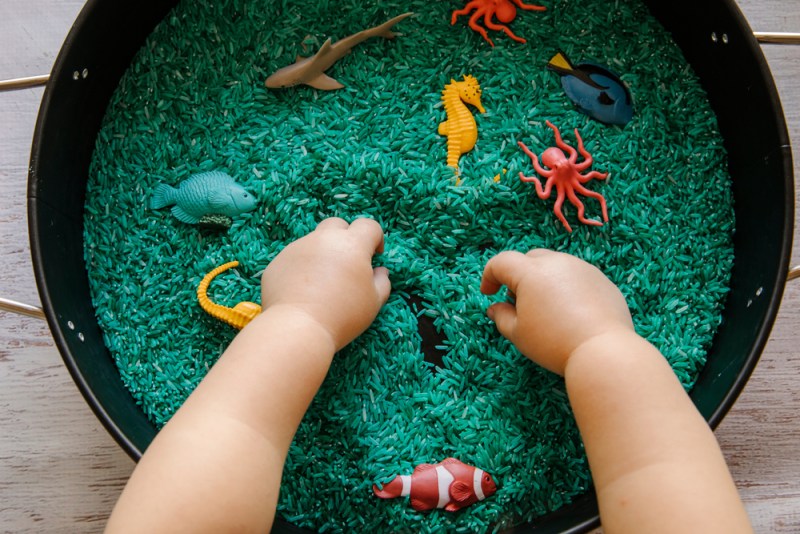Sensory play involves arranging a child’s environment in a way so they are able to play safely while engaging as many senses as possible. Providing toys and objects with stimulating colors, sights, sounds, smells, and textures help babies connect words with objects, fostering language development and other early learner objectives.
Having worked in the field of Applied Behavior Analysis (ABA) for almost a decade, I became an Assistant Behavior Analyst (BCaBA) in 2018. As a licensed behavior analyst, I watched children learn new skills, develop socially and emotionally, and become more independent through play and engaging their senses. It was inspiring and exciting to watch these children develop and grow.
The Science of Behavior

Based on behaviorism, Applied Behavior Analysis (ABA) uses play and naturalistic learning opportunities to teach larger skills by breaking them down. ABA practitioners use positive reinforcement to encourage behavior change and meet the goals of their clients and their families.
For the most part, I worked with children with disabilities, but I also worked in schools and interacted with “neurotypical children.” All kids (neurotypical children, children with autism, and children with other developmental differences) can have sensory-seeking behaviors and/or sensory aversions. Sometimes these issues are referred to as Sensory Processing Disorder (SPD). However, SPD is not yet recognized as a medical diagnosis.
For example, growing up my sister hated the feeling of glass on her hands. She got out of unloading the dishwasher many times with her complaints. Whether or not her discomfort was real or just a way of getting out of chores, we’ll likely never know. However, many kids complain about these types of issues, known as sensory aversions.
What is Sensory Aversion?

Occasionally disliking certain foods or loud sounds and bristling at rough textures are all common occurrences in toddlers. If you’ve ever attempted to put an itchy sweater on a toddler, then you know the struggle. As children get older their aversions may increase, become milder, or change. Depending on the child, aversions may only be a phase, but, severe sensory aversions may be a sign to investigate further.
When introducing new sensory experiences to your child, be gentle and allow them to explore, but don’t force the issue. “Behavioral treatments—such as gradually exposing a child to an offending sensory stimulus can help reduce anxiety,” according to the New York Times. In ABA, this is called desensitization. But there’s no need to push it too much. You can encourage kids by modeling, but it’s best to follow their cues. If they become uncomfortable, stop the activity and come back to it at another time. It should be a stress-free experience for all involved.
What is Sensory Seeking Behavior?

Sensory seeking behaviors are an associated feature of autism spectrum disorders. Someone with sensory seeking behaviors may enjoy certain activities and will go to great lengths to engage in their preferred behavior. They do this because they are undersensitive to stimuli and require more sensory input. Common sensory seeking behaviors include chewing on sleeves, rough play, making loud noises, and touching people or objects often. Giving these kiddos a fun sensory toy, water tables, sensory bins, and sensory bottles to play with may help redirect their sensory seeking behaviors (at least for a little while). Sometimes kiddos can have a combination of both sensory aversions and sensory seeking behaviors. Some children may dislike loud noises, yet be the loudest kiddo in the room.
Why is Sensory Play Important?

Sensory play is important for babies’ development in so many ways. Learning ways to cope with stress in a safe and loving environment is a major benefit. According to the American Academy of Pediatrics report, The Power of Play: A Pediatric Role in Enhancing Development in Young Children, children learn social cues, improve cognitive development, and learn ways to self-regulate while playing with others and while using their senses during play.
Caregivers can encourage their babies and toddlers by giving them room to safely explore and engage all of their senses. Sight, smell, hearing, touch, and taste are the five most common known senses, but bodily awareness (proprioception) and balance (vestibular) are lesser-known. There are several sensory toys for babies and toddlers available, but you can also cheaply make sensory tables, sensory bottles, sensory bins, and more! Even the simple act of letting a kid play with a plastic trowel and some dirt has a bunch of positive effects.
Sensory Toys

A plethora of sensory toys are on the market today. Simple toys like Legos, blocks, wooden toys, and puzzles, can give toddlers rich sensory experiences. Playing music, singing, and talking about your experiences will help your child learn how language works and help them form memories. Doodle boards, sensory balls and blocks, inflatable mats, "busy" mats, and light up maracas are all toys that will help your baby and toddler safely explore and engage all of their senses. For older kiddos, thinking putty, kinetic sand, stress balls, and a marble run set are perfect for engaging their senses during play.
DIY Sensory Experiences

DIY sensory bins, sensory bottles, and water tables don’t have to be expensive or excessive. Hundreds of blogs and Pinterest boards dedicated to sensory play will keep kiddos busy for some time.
Always make sure to supervise kiddos while they are engaging in sensory play. Getting down and playing with them if possible is even better. Container play is amazing and less of a mess, but “messy play” still has a great number of benefits for kids. Activities like finger painting, shaving cream activities, and making mudpies in the backyard are all fun and beneficial activities for kiddos.
